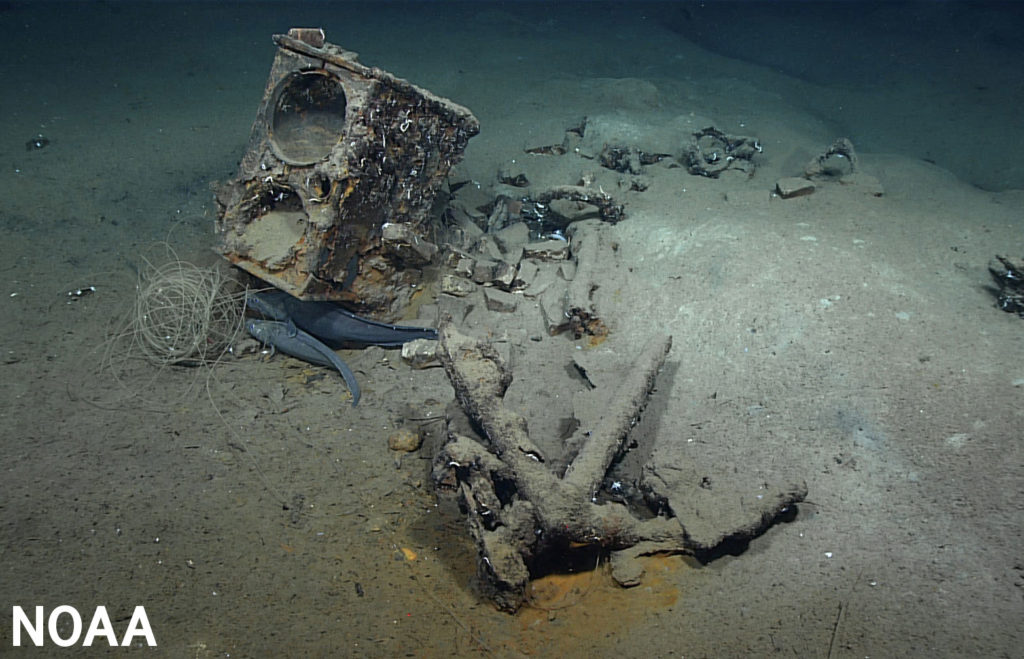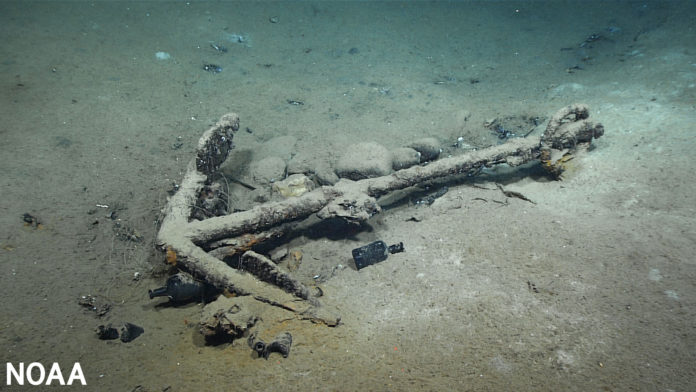A team aboard NOAA Ship Okeanos Explorer piloted a remotely operated vehicle (ROV) to explore the seafloor of the Gulf of Mexico on February 25. The team discovered a wreck of a 207-year-old whaling ship called Industry.
They found the remains of a 64-foot long, two-masted wooden brig. This discovery opens a window into a little-known chapter of American history.
U.S. Deputy Secretary of Commerce Don Graves said, “Black and Native American history is American history. This critical discovery serves as an important reminder of Black and Native Americans’ vast contributions to our country. This 19th-century whaling ship will help us learn about the lives of the Black and Native American mariners and their communities and the immense challenges they faced on land and at sea.”
With the guidance provided via a satellite connection from partner scientists onshore, the ROV explored the seafloor at a suspected location. An energy company first spotted the location in 2011. In 2017, an autonomous vehicle briefly viewed the location, but it was never fully examined.
Armed with a broad examination of the Industry and a video of the ROV, the team of scientists from the coast has now affirmed that it is most likely the brig Industry.
ROV captured high-resolution video to fully document the wreck site found 6,000 feet below the Gulf’s surface. The ROV drifted over the telltale tryworks, a cast-iron stove with two large kettles used to render blubber into oil. The NOAA group affirmed that the wreck’s estimations matched Industry’s in historical documents.

NOAA Administrator Rick Spinrad, Ph.D., said, “Today we celebrate the discovery of a lost ship that will help us better understand the rich story of how people of color succeeded as captains and crew members in the nascent American whaling industry of the early 1800s. The discovery reflects how African Americans and Native Americans prospered in the ocean economy despite discrimination and other injustices. It is also an example of how important partnerships of federal agencies and local communities are to uncovering and documenting our nation’s maritime history.”
The Industry brig was built in 1815 in Westport, Massachusetts. It hunted whales across the Atlantic Ocean, the Caribbean, and the Gulf of Mexico for 20 years.
The brig was lost when a strong storm snapped its masts and opened its hull to the ocean on May 26, 1836. It is the only whaling ship known to have been lost in the Gulf of Mexico out of 214 whaling voyages linked from the 1780s to the 1870s.
SEARCH Inc., working with the Bureau of Ocean Energy Management, plans to nominate the wreck site for the National Register of Historic Places as part of a larger BOEM project led by SEARCH to document historic 19th-century shipwrecks in the Gulf of Mexico.
Carl J. Cruz, a New Bedford-based independent historian and a descendent of the family of Paul Cuffe, said, “The news of this discovery is exciting, as it allows us to explore the early relationships of the men who worked on these ships, which is a lesson for us today as we deal with diversity, equity, and inclusion in the workplace.”
Lee Blake, president of the New Bedford Historical Society, who played a role in the development of the Captain Paul Cuffe Park and an African American and Native American Heritage Trail, said, “Finding the Industry is an amazing opportunity to tell a much fuller story of Paul Cuffe’s accomplishments as a whaling captain, businessman and social activist bent on finding a way to end the slave trade.”
The team also determined the shipwreck’s location, 72 nautical miles from the last recorded location off the mouth of the Mississippi River. It could be attributed to the still-floating ship within the Gulf of Mexico’s Loop Current.
Somerset said, “That there were so few artifacts on board was another big piece of evidence it was Industry. We knew it was salvaged before it sank. A whaling ship from the tight-knit Massachusetts community of whalers had visited the sinking Industry and removed 230 barrels of whale oil, parts of the rigging, and one of the four anchors before it sank.”
